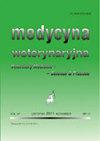马隐睾症的诊断。
IF 0.4
4区 农林科学
Q4 VETERINARY SCIENCES
Medycyna Weterynaryjna-Veterinary Medicine-Science and Practice
Pub Date : 2023-01-01
DOI:10.21521/mw.6797
引用次数: 0
摘要
隐睾症是马最常见的先天性畸形,由睾丸从腹腔下降到阴囊失败引起。结果,尽管维持了种马的类固醇性激素和反米勒激素的产生和分泌以及行为特征,但仍有部分或完全丧失生殖潜力。隐睾的确切位置是通过对隐睾内部进行彻底的临床检查来确定的,并辅以腹股沟区域的超声检查,以及膀胱区域和腹股沟管内环的经直肠超声可视化。一些遗传学研究的结果表明隐睾有遗传基础。对于疑为隐睾症的马(无已知临床病史的半阉割动物),有必要测定雄激素水平和抗穆勒激素水平,并进行促绒毛膜促性腺激素诱导的睾酮生成刺激试验(Cox试验)。在手术切除之前,需要知道保留睾丸的确切位置,以便在手术技术和选择适当的麻醉方面做出最佳决定。本文章由计算机程序翻译,如有差异,请以英文原文为准。
Diagnostic of cryptorchidism in horses.
Cryptorchidism in horses is the most common congenital malformation, caused by a failure in the descent of testicles from the abdominal cavity into the scrotum. As a result, there is a partial or complete loss of reproductive potential although the production and secretion of steroid sex hormones and anti-Mueller hormone, as well as behavioral characteristics of the stallion, are maintained. The exact location of the undescended testis is established through a thorough clinical examination of the interior (of the cryptorchid horse), supported by an ultrasound examination of the inguinal region, and the transrectal ultrasound visualization of the bladder area and the inner ring of the inguinal canal. The results of several genetic studies suggest a genetic basis for cryptorchidism. In particularly difficult cases of suspected cryptorchidism in horses (hemi-castrated animals without a known clinical history), it is necessary to determine androgenic hormone levels and the anti-Mueller hormone level and to perform a testosterone production stimulation test with hCG induction (Cox test). The exact location of the retained testicle needs to be known before surgical removal so that optimal decisions can be made regarding the technique of the procedure and selection of appropriate anaesthesia.
求助全文
通过发布文献求助,成功后即可免费获取论文全文。
去求助
来源期刊

Medycyna Weterynaryjna-Veterinary Medicine-Science and Practice
VETERINARY SCIENCES-
CiteScore
0.80
自引率
0.00%
发文量
73
审稿时长
4-8 weeks
期刊介绍:
"Medycyna Weterynaryjna" publishes various types of articles which are grouped in the following editorial categories: reviews, original studies, scientific and professional problems, the history of veterinary medicine, posthumous memoirs, as well as chronicles that briefly relate scientific advances and developments in the veterinary profession and medicine. The most important are the first two categories, which are published with short summaries in English. Moreover, from 2001 the editors of "Medycyna Weterynaryjna", bearing in mind market demands, has also started publishing entire works in English. Since 2008 the periodical has appeared in an electronic version. The following are available in this version: summaries of studies published from 1999 to 2005, full versions of all the studies published in the years 2006-2011 (in pdf files), and full versions of the English studies published in the current year (pdf). Only summaries of the remaining studies from the current year are available. In accordance with the principles accepted by the editors, the full versions of these texts will not be made available until next year.
All articles are evaluated twice by leading Polish scientists and professionals before they are considered for publication. For years now "Medycyna Weterynaryjna" has maintained a high standard thanks to this system. The review articles are actually succinct monographs dealing with specific scientific and professional problems that are based on the most recent findings. Original works have a particular value, since they present research carried out in Polish and international scientific centers.
 求助内容:
求助内容: 应助结果提醒方式:
应助结果提醒方式:


